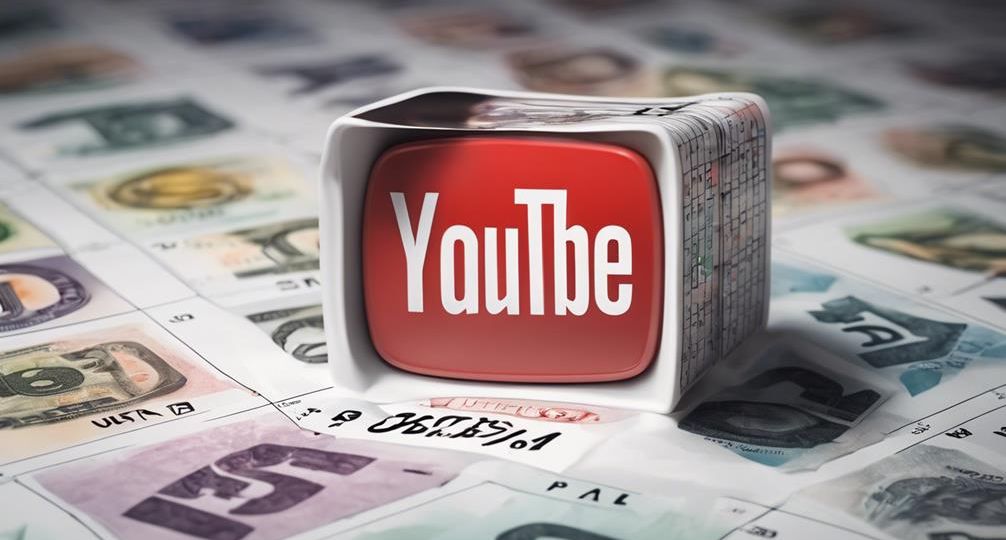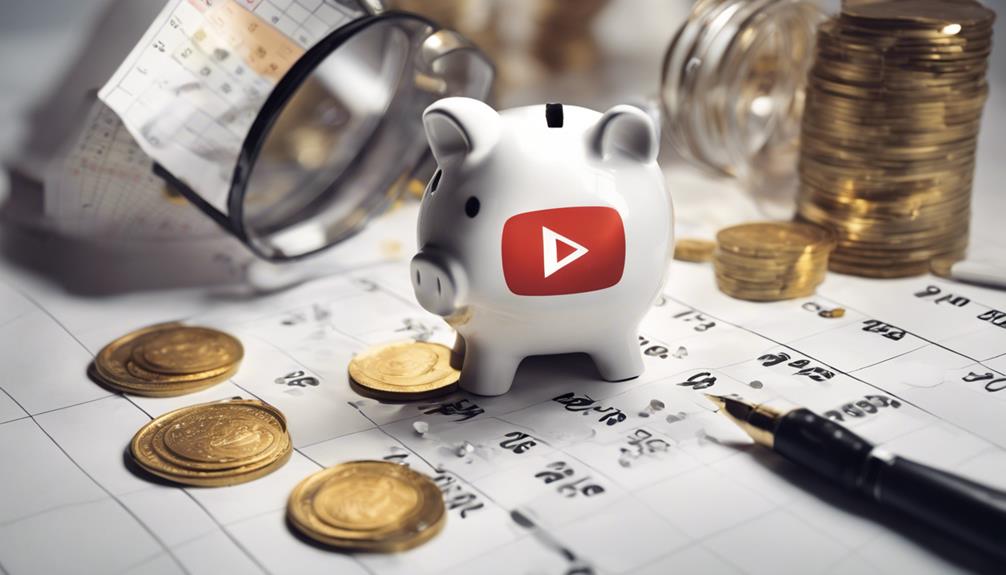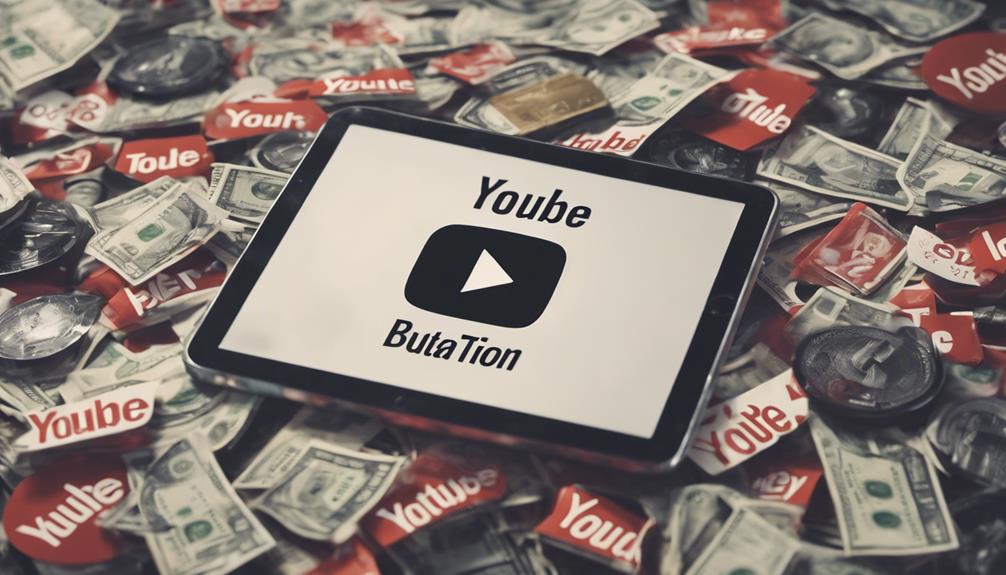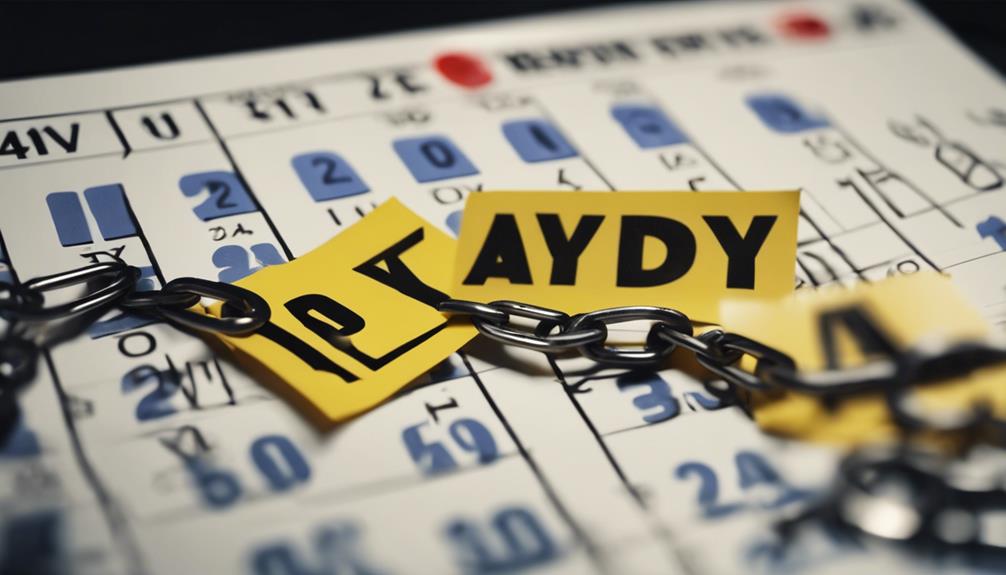
Does YouTube pay monthly?
Just as the moon predictably graces the night sky each month, you may wonder if YouTube, the world’s largest video platform, pays its contributors on a similar monthly cycle.
While it’s true that YouTube has a monetization system that can yield earnings, is it as regular and guaranteed as lunar cycles?
Let’s embark on this journey of understanding the nuances of YouTube’s payment system, the variables that influence it, and whether you can anticipate a consistent monthly income.
Key Takeaways
- Yes, YouTube pays creators on a monthly basis through AdSense, once they reach the $100 threshold.
- The payment calculation is based on views, engagement, ads, channel memberships, and YouTube Premium subscriptions.
- Troubleshooting delayed payments may involve updating payment details or reaching out to support.
- Diversifying income sources and optimizing viewer engagement can enhance monthly earnings.
Understanding YouTube’s Monetization System

Diving into YouTube’s monetization system can help you comprehend how the platform compensates content creators on a monthly basis. Unlike traditional media, where revenue comes from ads and subscriptions, YouTube’s model is more complex. You’re not just dealing with a single revenue stream, but a plethora of monetization alternatives, each with its own set of rules and potential copyright issues.
Ads are the most recognized form of monetization. Every time a viewer watches an ad on your video, you get a cut. However, this isn’t the only way to earn. Channel memberships, merchandise shelf, Super Chat, and YouTube Premium revenue are other avenues to boost your earnings.
Copyright issues can come into play, affecting your monetization. If a copyright claim is made on your content, any ad revenue it generates goes to the claimant. Therefore, it’s vital to create original content or get the necessary permissions to use copyrighted material.
In essence, YouTube’s monetization system is a multifaceted, dynamic machine that requires an innovative mind to navigate successfully. Understanding its intricacies can help you maximize your earning potential on the platform.
Eligibility Requirements for Earning
Before you can start earning from YouTube, it’s crucial to understand the platform’s monetization criteria and how to maintain your eligibility. You’ll need to meet specific requirements, which include aspects such as the number of subscribers, total viewing hours, and adherence to YouTube’s community guidelines.
This stringent set of rules ensures that only those creators who consistently produce quality content can profit from their videos.
Understanding YouTube’s Monetization Criteria
To start earning from your YouTube channel, it’s crucial to understand the platform’s monetization criteria and how changes in these criteria can impact the quality of your content. Notably, YouTube’s monetization criteria have evolved over the years, reflecting the platform’s need to maintain a positive user experience while rewarding creators for their effort. Primarily, there are three critical aspects in this context:
- You must live in a country/region where the YouTube Partner Program is available.
- Your channel must have more than 1,000 subscribers and 4,000 watch hours over the past 12 months.
- You need to adhere to all of YouTube’s policies and guidelines.
Meeting these criteria isn’t just a prerequisite for monetization, but it also signifies the quality and popularity of your content.
Maintaining Earning Eligibility
While meeting YouTube’s initial monetization criteria is a critical first step, it’s equally important to maintain your eligibility to continue earning from your content. Your earning consistency can make or break your financial success on this platform.
It’s essential to understand the factors influencing your earnings, including subscriber engagement, ad relevance, and video quality. Payment fluctuations are par for the course, reflecting changes in viewer behavior and advertiser spending.
It’s innovative to leverage these metrics, adjusting your content strategy based on what’s working and what’s not. Remember, YouTube’s algorithm favors channels that consistently produce engaging, high-quality content.
How YouTube Calculates Payments

You might wonder how YouTube calculates the payments you receive.
It’s crucial to grasp YouTube’s revenue model to fully understand this process.
YouTube’s Revenue Model
Diving into the intricacies of YouTube’s revenue model, it’s crucial to understand that payments are calculated based on a blend of factors: primarily, the number of views your videos garner and the engagement they receive. This platform’s business model is more complex than it first appears, with a significant role played by:
- YouTube’s subscription service.
- Advertisements.
- Channel memberships.
YouTube’s subscription service, YouTube Premium, provides an ad-free experience for viewers, but also contributes to your revenue as a content creator. Advertisements, on the other hand, are what most people think of when considering YouTube revenue. Lastly, channel memberships allow loyal viewers to support your channel directly.
However, revenue sharing controversies have arisen, questioning the fairness of the platform’s payment calculations.
Understanding Payment Breakdown
To fully grasp how YouTube calculates payments, it’s crucial to delve into the specific factors involved, such as ad revenue, channel memberships, and YouTube Premium revenue. The platform’s innovative payment methods distribute earnings based on ad impressions and clicks. You’re paid more for ads viewed in entirety and clicks on the ad itself.
Channel memberships also contribute to your earnings, with subscribers paying a monthly fee for exclusive content. The revenue from these memberships is shared between you and YouTube.
YouTube Premium revenue comes from users who pay for an ad-free experience. Here, you get a portion of the subscription fee based on how much time Premium users spend watching your content.
Lastly, video licensing can provide additional income when companies pay to use your content. Understanding these elements helps you maximize your YouTube earnings.
The Role of AdSense in Payments
In understanding YouTube’s payment process, one can’t overlook the indispensable role of AdSense, which serves as the primary channel for monetizing your videos. This Google-owned advertising network allows you to earn revenue by displaying targeted ads alongside your content.
However, it’s also important to understand the restrictions that come along with AdSense. Not all content is eligible for monetization, and violation of these guidelines can lead to your account being suspended or even terminated.
With the possibility of AdSense restrictions, it’s wise to consider AdSense alternatives. Here are three you might want to explore:
- Patreon: A platform where fans can directly support their favorite creators.
- Affiliate marketing: You can earn commissions by promoting others’ products in your videos.
- Sponsorships: Brands might be interested in sponsoring your videos for a fee.
All these channels provide innovative ways to monetize your content, offering more control and potentially higher earnings than AdSense. However, each comes with its own set of challenges and requirements, which you’ll need to navigate successfully to reap the benefits. Remember, diversifying your income sources is a smart strategy in the ever-evolving digital landscape.
Understanding CPM (Cost Per Mile)

While exploring different ways to monetize your YouTube content, it’s crucial to get a solid grasp on CPM, or Cost Per Mile. This is a key metric in digital advertising, determining how much an advertiser pays for a thousand views of their ad. The CPM impact on your earnings can be significant, as a higher CPM means greater revenue.
From an advertiser perspective, CPM allows them to make cost-effective decisions. They can analyze how much they’re willing to pay for their ad to reach a thousand viewers. Simultaneously, as a content creator, you’re looking to attract advertisers with high CPMs to maximize your earnings.
Consider the table below, emphasizing the interaction between CPM and earnings:
| Views (in thousands) | CPM ($) | Earnings ($) |
|---|---|---|
| 10 | 1 | 10 |
| 10 | 5 | 50 |
| 50 | 1 | 50 |
| 50 | 5 | 250 |
| 100 | 5 | 500 |
As seen, increasing either the CPM or the views can significantly boost your earnings. Understanding CPM is therefore essential to optimize your YouTube monetization strategy.
Importance of Viewer Engagement
Beyond the reach of your videos, viewer engagement plays a pivotal role in maximizing your YouTube earnings. It’s not just about getting views, it’s about keeping your audience hooked throughout. Viewer retention, in this regard, is critical. An engaged viewer is likely to watch your content in its entirety, increasing your channel’s overall watch time, a key metric YouTube uses when recommending videos.
Analyzing your audience demographics is equally important. Understanding who your viewers are, what they prefer, and when they’re most active can help you tailor your content, hence boosting engagement.
Here are three innovative strategies to enhance viewer engagement:
- Create Interactive Content: Use polls, Q&As, or live chats in your videos to involve your viewers and make them feel part of the content creation process.
- Foster a Community: Encourage comments, respond to them, and acknowledge your audience’s participation. This makes them feel valued and increases their likelihood of returning.
- Use Analytics: Leverage YouTube’s analytics to understand your viewers’ behavior and preferences, and adjust your content accordingly.
In essence, the recipe for higher earnings on YouTube isn’t just about views, it’s predominantly about engagement and understanding your audience.
How Sponsorships Influence Earnings

Shifting our focus slightly, it’s essential to recognize how sponsorships can significantly boost your earnings on YouTube. As an innovative content creator, you must understand the financial benefits that brand partnerships and influencer marketing can bring.
Here’s a table that outlines how sponsorships can impact your YouTube earnings:
| Types of Sponsorships | Impact on Earnings |
|---|---|
| Brand Partnerships | Brands typically pay creators a pre-agreed amount for product placement or reviews, significantly increasing your earnings. |
| Influencer Marketing | As an influencer, you can promote products or services to your followers, which can earn you a commission per sale or a flat fee, enhancing your revenue. |
These sponsorships can exponentially increase your revenue, but it’s important to choose the right ones. Working with a brand that resonates with your audience can lead to higher viewer engagement and better conversion rates, which can further boost your earnings.
However, you must maintain authenticity and transparency. Your audience values your genuine opinion, and any perceived sell-out can harm your reputation and viewership. Therefore, balancing earnings from sponsorships while sustaining viewer trust is key in the innovative world of YouTube content creation.
Other Revenue Streams on YouTube
Diving deeper into the monetization pool of YouTube, you’ll find that sponsorships and ad revenue are just the tip of the iceberg. There’s a vast ocean of opportunities to maximize your financial gains. Let’s delve into some of these additional revenue streams.
- Merchandise Selling: YouTube allows you to showcase your merchandise right below your video content. If you’ve got a substantial following, they’re likely to buy what you’re selling. From custom t-shirts to coffee mugs, there’s a broad range of items you can profit from.
- Affiliate Marketing: This is another lucrative method to earn extra income. By promoting products or services of other companies, you can earn a commission for every sale made through your referral link.
- Crowdfunding and Donations: Platforms like Patreon or GoFundMe can be integrated into your YouTube channel. Your loyal viewers can show their support by donating, providing a direct, heartfelt income stream.
Unconventional and innovative, these strategies could drastically elevate your YouTube earnings. It’s not just about ad revenue and sponsorships anymore. With creativity and strategic planning, YouTube can become a multifaceted source of income.
Troubleshooting Delayed YouTube Payments

Navigating the tricky waters of delayed YouTube payments can be quite daunting, especially if you’re unsure of what’s causing the delay or how to address it. It’s important to understand this: YouTube’s payment methods and processes are efficient, but sometimes, circumstances may lead to delayed payments.
Firstly, check if your AdSense account has reached the $100 threshold, as payments are only triggered once you hit this mark. Secondly, ensure that your payment details are correct. Incorrect or outdated information can cause delays.
| Potential Issue | Solution |
|---|---|
| Haven’t reached $100 threshold | Keep creating and monetizing content |
| Incorrect payment details | Update your payment information |
If both these aspects are in order, the delay might be due to YouTube’s payment cycle. Payments are usually processed between the 21st and the 26th of each month. If you haven’t received your payment by the end of the month, reach out to YouTube’s support.
Don’t fret over delayed payments. With a proper understanding of the payment methods and a bit of patience, you can effectively navigate and resolve such issues.

